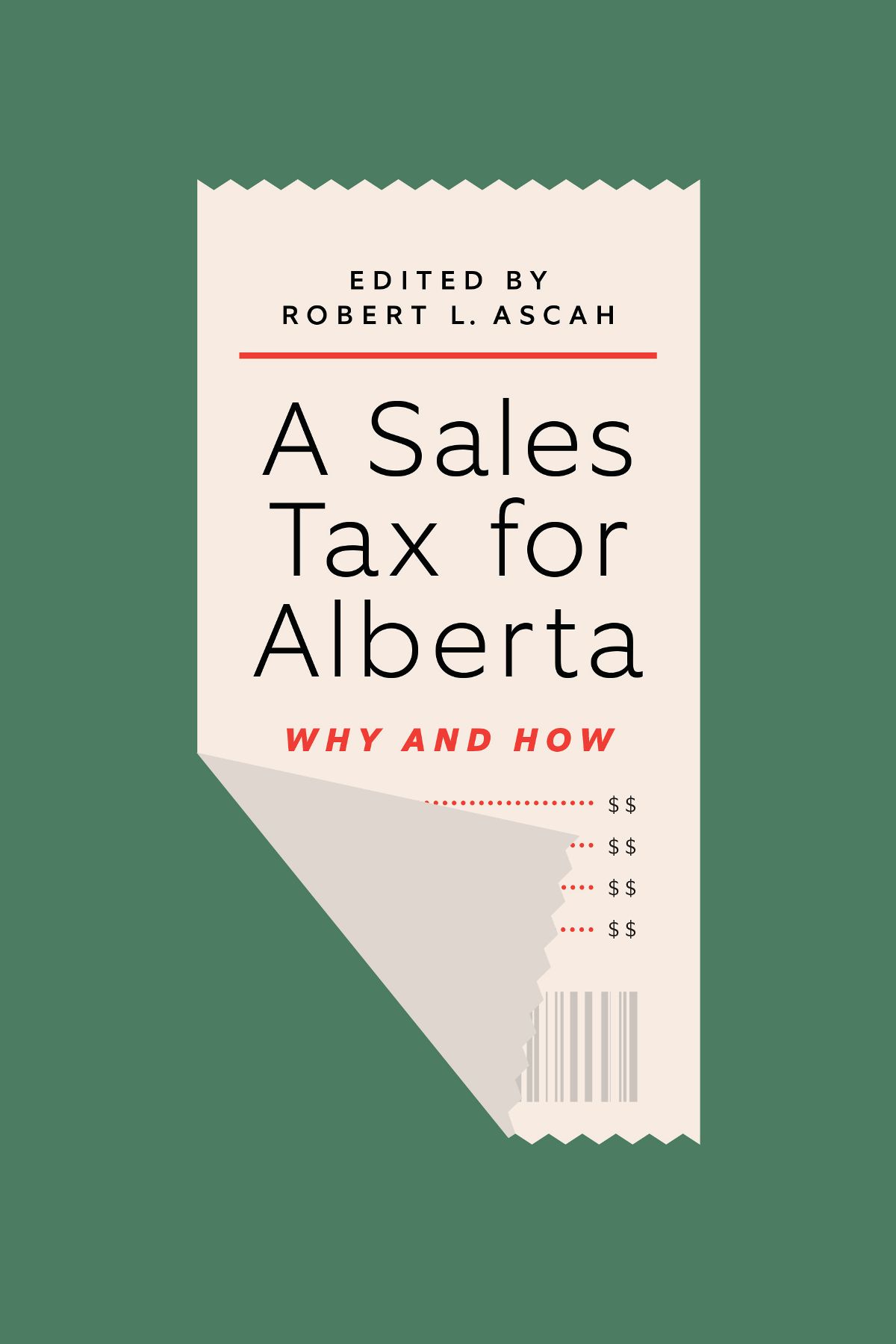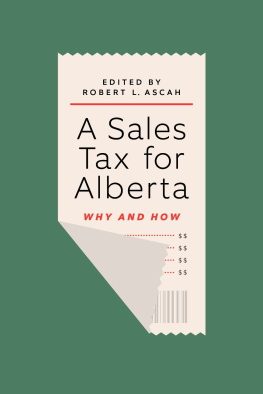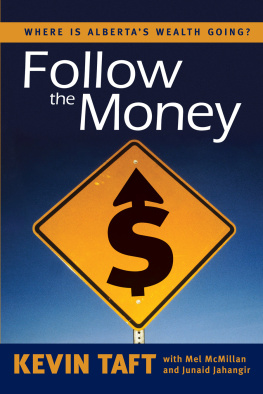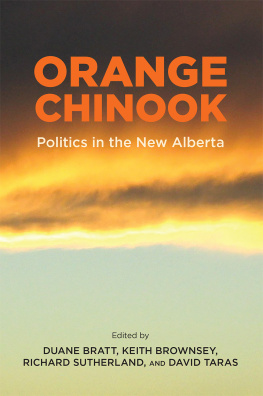
A Sales Tax for Alberta
A Sales Tax for Alberta Why and How
Edited by Robert L. Ascah

Copyright 2022 Robert L. Ascah
Published by AU Press, Athabasca University
1 University Drive, Athabasca, AB T9S 3A3
https://doi.org/10.15215/aupress/9781771992978.01
Cover design by Natalie Olsen, kisscutdesign.com
Printed and bound in Canada
Library and Archives Canada Cataloguing in Publication
Title: A sales tax for Alberta : why and how / edited by Robert L. Ascah.
Names: Ascah, Robert L. (Robert Laurence), 1954 editor.
Description: Includes bibliographical references.
Identifiers: Canadiana (print) 20220190291 | Canadiana (ebook) 20220190348 | ISBN 9781771992978 (softcover) | ISBN 9781771992985 (PDF) | ISBN 9781771992992 (EPUB)
Subjects: LCSH: Sales taxAlberta. | LCSH: Fiscal policyAlberta.
Classification: LCC HJ5715.C22 A43 2022 | 336.2/713097123dc23
We acknowledge the financial support of the Government of Canada through the Canada Book Fund (CBF) for our publishing activities and the assistance provided by the Government of Alberta through the Alberta Media Fund.


Please contact AU Press, Athabasca University at for permissions and copyright information.
This publication conforms to the EPUB Accessibility 1.0 specification of WCAG 2.0 Level AA.
Contents
Kevin Taft
Robert L. Ascah
Graham Thomson
Robert L. Ascah
Robert L. Ascah
Melville McMillan
Ergete Ferede
Elizabeth Smythe
Ian Glassford
Kenneth J. McKenzie
Robert L. Ascah
Trevor W. Harrison
Figures and Tables
Figures
Tables
Selected Abbreviations
The following terms are consistently abbreviated in this volume.
CIT corporate income tax
GDP gross domestic product
GST goods and services tax
HST harmonized sales tax
NDP New Democratic Party
PIT personal income tax
PST provincial sales tax
UCP United Conservative Party
Foreword
Alberta is undergoing a painful economic transition, and this book is well positioned to inform some of the critical debates concerning the provinces financial future. Until about 2013, Albertas economy had been outperforming the rest of Canadas for so long that it seemed a given. In 2005, TD Economics reported that GDP per capita in the Calgary-Edmonton corridor was a gigantic 47 percent above the Canadian average, as well as substantially above the average in the United States.
The fall from these economic heights was dramatic. Albertas GDP peaked in 2014, shrank over the next two years, recovered partially from 2017 to 2019, only to drop again in 2020 to a new low.
Provincial finances faced an equivalent upheaval. In the 201011 fiscal year, the Alberta government had no net debt, and its AAA credit rating was the best among Canadas provinces.
As dramatic as they are, these changes are only the early stages of a much longer and more profound economic restructuring of the province. For years, successive Alberta governments have allowed the provinces economy, politics, and self-identity to be tied to the ups and downs of the petroleum industry. At a peak, almost 40 percent of the provinces economy was directly or indirectly dependent on this one industry. But as the world has begun to shift away from petroleum in order to combat global warming, the economic foundations of Alberta have started to crumble. Not even the surge in oil prices in 2022 could lead to a boom in Alberta.
The truth is there has been a hole in the Alberta governments finances for nearly six decades. As Bob Ascah notes in chapter 3, in every fiscal year since 196566, the Alberta government has relied on natural resource revenues to balance its books. Those revenues are no longer large enough to continue plugging that hole, and as the debt increases, the hole gets bigger.
So the great political question in Alberta has become, How should the province balance its budget?
Alberta cannot realistically hope to balance its budget simply by cutting expenses. The financial gap is too large. As Mel McMillan demonstrates in chapter 5, for the Alberta government to balance its budget by 202223 through cuts alone, program spending would need to be reduced by 20 to 25 percent. This would lower program spending to levels not known in more than fifty years, which is unlikely to be politically, socially, or economically acceptable.
If cuts alone are not the answer, though, then new sources of revenue will need to be found. Where will this money come from? This book provides much of the answer. An essential part of the solution to Albertas fiscal crisis is a sales tax.
The province has, of course, long prided itself for its low taxes and its lack of a sales tax. From 2001 to 2012, I served as an opposition member of the Alberta legislature, and every year the budget speech included an update on how much lower Albertas taxes were than those in other provinces. If Albertans and Alberta businesses were in any other province, the 2008 budget speech reminded us, they would pay between about $10 billion to $18 billion more in taxes, every single year.
To put the point another way, the Alberta government has been choosing to sacrifice billions of dollars in income each year. In the face of todays fiscal crisis, Albertas continuing commitment to extremely low taxes seems reckless. As McMillan points out, a provincial sales tax of only 5 percentlower than that of any other provincewould have provided about $5.3 billion to the Alberta treasury in 201920. The Alberta Advantage is proving to be a liability.
The people of Alberta face some hard choices. No one is ever eager to pay more taxes. But how many schools and hospitals will we be willing to close, how many nurses and police officers will we agree to lay off, how many roads and public buildings will we allow to deteriorate before we face current realities? We can sit back and watch Albertas credit rating slowly decline until the province loses its capacity to borrow money in order to make ends meet. Or we can confront the need to bring our tax regime into better alignment with those in other jurisdictions.
That need is increasingly urgent, and the province cannot afford to go on dismissing the possibility of a sales tax. As this book makes clear, a moderate sales tax, combined with some measure of fiscal restraint, could put the province on sustainable financial ground while still enabling it to maintain its status as a low-tax jurisdiction. Chapter by chapter, the contributors to this book deliver an invaluable guide to the economic rationale for a sales tax in Alberta and to the issues surrounding the implementation of one.
A sales tax cannot and will not be the entire solution to the Albertas fiscal crisis. Nor will any other single tactic. As the authors in this collection make abundantly clear, however, it is difficult to imagine a solution that would provide the province with a stable financial future that does not include the introduction of a sales tax.
Kevin Taft
Notes
, 2.
.
.
Alberta Treasury Board and Finance,











